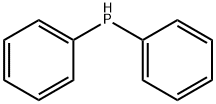Diphenylphosphine

|
- ₹130995
- Product name: Diphenylphosphine
- CAS: 829-85-6
- MF: C12H11P
- MW: 186.19
- EINECS:212-591-4
- MDL Number:MFCD00003040
- Synonyms:PHOSPHINE, DIPHENYL;Diphenyl-phosphane ;Diphenyl phospine;Diphenylphosphine,99%;Diphenylphosphine,99%(10wt%inhexane);DIPHENYLPHOSPHINE;AURORA KA-1107;DIPHENYLPHOSPHINE OR PHOSPHINE, DIPHENYL
1 prices
Selected condition:
Brand
- ottokemi
Package
- 50gm
- Manufacturerottokemi
- Product number D 8307
- Product descriptionDiphenylphosphine
- Packaging50gm
- Price₹130995
- Updated2022-05-26
- Buy
| Manufacturer | Product number | Product description | Packaging | Price | Updated | Buy |
|---|---|---|---|---|---|---|
| ottokemi | D 8307 | Diphenylphosphine | 50gm | ₹130995 | 2022-05-26 | Buy |
Properties
Melting point :-14.5 °C
Boiling point :280 °C(lit.)
Density :1.07 g/mL at 25 °C(lit.)
vapor pressure :2 mm Hg ( 110 °C)
refractive index :n20/D 1.625(lit.)
Flash point :-18°C (Hexane)
storage temp. :2-8°C
solubility :Chloroform
form :liquid
pka :diphenylphosphine is weakly basic. The pKa of the protonated derivative is 0.03.
color :colorless
Specific Gravity :0.68
Water Solubility :Miscible with ethanol, ether, benzene, concentrated hydrochloric acid. Immiscible with water.
Sensitive :Air & Moisture Sensitive
Hydrolytic Sensitivity :8: reacts rapidly with moisture, water, protic solvents
BRN :742504
InChIKey :GPAYUJZHTULNBE-UHFFFAOYSA-N
CAS DataBase Reference :829-85-6(CAS DataBase Reference)
NIST Chemistry Reference :Phosphine, diphenyl-(829-85-6)
Boiling point :280 °C(lit.)
Density :1.07 g/mL at 25 °C(lit.)
vapor pressure :2 mm Hg ( 110 °C)
refractive index :n
Flash point :-18°C (Hexane)
storage temp. :2-8°C
solubility :Chloroform
form :liquid
pka :diphenylphosphine is weakly basic. The pKa of the protonated derivative is 0.03.
color :colorless
Specific Gravity :0.68
Water Solubility :Miscible with ethanol, ether, benzene, concentrated hydrochloric acid. Immiscible with water.
Sensitive :Air & Moisture Sensitive
Hydrolytic Sensitivity :8: reacts rapidly with moisture, water, protic solvents
BRN :742504
InChIKey :GPAYUJZHTULNBE-UHFFFAOYSA-N
CAS DataBase Reference :829-85-6(CAS DataBase Reference)
NIST Chemistry Reference :Phosphine, diphenyl-(829-85-6)
Safety Information
| Symbol(GHS): |
 
|
|||||||||||||||||||||||||||||||||||
|---|---|---|---|---|---|---|---|---|---|---|---|---|---|---|---|---|---|---|---|---|---|---|---|---|---|---|---|---|---|---|---|---|---|---|---|---|
| Signal word: | Danger | |||||||||||||||||||||||||||||||||||
| Hazard statements: |
|
|||||||||||||||||||||||||||||||||||
| Precautionary statements: |
|
Description
Diphenylphosphine acts as an intermediate in the preparation of diphenylphosphide derivatives, phosphonium salts, phosphine ligands and Wittig-Horner reagents. The presence of hydrogen atom bonded to phosphorus undergoes Michael-like addition to activated alkenes. It is involved in the preparation of 1,2-bis(diphenylphosphino)ethane and (phenyl-(phenylmethyl)phosphoryl)benzene. Further, it is used in the synthesis of aminophosphines and chiral palladacycles with N-heterocyclic carbene ligands as catalysts.More related product prices
Dithizone 1,3-Diphenyl-2-thiourea Diphenylthiocarbazide Dichlorodiphenylsilane Ethyl diphenylphosphinite 1,5-Diphenylcarbazide Diphenyldimethoxysilane Diphenylphosphinic acid Diphenyl-2-pyridylphosphine 6372-42-5 Chlorodiphenylphosphine Triphenylphosphine oxide 5074-71-5 TRIPHENYLPHOSPHINE DIBROMIDE 1,3-Bis(diphenylphosphino)propane 12150-46-8 Diphenylphosphinyl chloride 1,2-Bis(diphenylphosphino)ethane 1,4-Bis(diphenylphosphino)butane 2136-75-6Related product price
- Dithizone
₹920-28680.01 - 1,3-Diphenyl-2-thiourea
₹820-6600 - Diphenylthiocarbazide
₹9100
Suppliers and manufacturers
OCEAN TRADING CORPORATION
CLEARSYNTH LABS LTD.
Otto Chemie Pvt. Ltd.
Puyang Huicheng Electronic Materials Co., Ltd.
Shanghai Daken Advanced Materials Co.,Ltd
Henan Tianfu Chemical Co.,Ltd.
Hangzhou FandaChem Co.,Ltd.
ATK CHEMICAL COMPANY LIMITED






